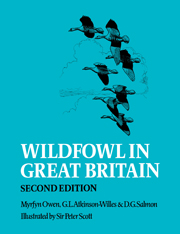Book contents
- Frontmatter
- Contents
- List of location maps
- Foreword by William Wilkinson
- Acknowledgements
- Conventions and abbreviations
- Part I Introduction
- Introduction to the survey
- Wildfowl Counts
- Wildfowl ringing
- Information from shot birds
- Part II The survey of wildfowl habitat and distribution
- Part III Species accounts
- Part IV The conservation of wildfowl and their habitats
- Conclusion
- References
- Indexes
Information from shot birds
Published online by Cambridge University Press: 04 August 2010
- Frontmatter
- Contents
- List of location maps
- Foreword by William Wilkinson
- Acknowledgements
- Conventions and abbreviations
- Part I Introduction
- Introduction to the survey
- Wildfowl Counts
- Wildfowl ringing
- Information from shot birds
- Part II The survey of wildfowl habitat and distribution
- Part III Species accounts
- Part IV The conservation of wildfowl and their habitats
- Conclusion
- References
- Indexes
Summary
Traditionally, wildfowlers have contributed much to our knowledge of wildfowl numbers, distribution and habits, although early information was not as rigidly quantitative as we might have liked. The early writings and reminiscences of shooters, such as Colonel Hawker (254), John Millais (344) and others (285), often provide the only accounts of the abundance of wildfowl against which present numbers and distribution can be judged. Later, wildfowlers began to contribute scientific data on habits and foods which were valuable in the understanding of the requirements of the birds (107, 110). When biologists began studying ecological aspects of wildfowl in detail in the late 1950s and 1960s, wildfowlers became part of the collecting mechanism; information or samples supplied by them still provide a valuable source of scientific information.
Duck production surveys
Whereas geese and swans can be aged by observation in the field and valuable information on production and population dynamics so gained, ducks are only reliably aged in the hand. We have seen that the age ratios of caught ducks give unreliable estimates of the proportion of young in the population (p.18) and considerable efforts have been expended in attempting to collect such information from shot birds. A preliminary key to the sex and age identification of wildfowl from wings only was published in 1964 by the United States Fish and Wildlife Service (117) and this provided a stimulus to a pilot study in Britain in 1965 (246). Wildfowlers were asked to send in a single wing from ducks they shot and these were examined by experts who classified them by species, sex and age (adult or first winter).
- Type
- Chapter
- Information
- Wildfowl in Great Britain , pp. 20 - 24Publisher: Cambridge University PressPrint publication year: 1986

